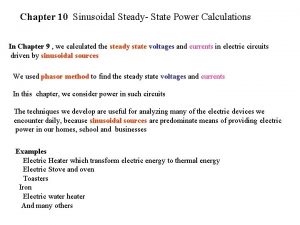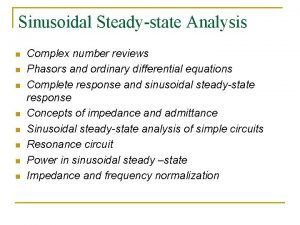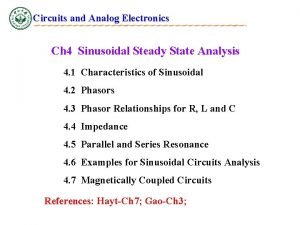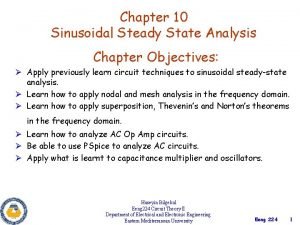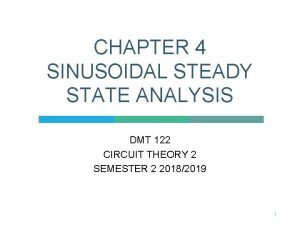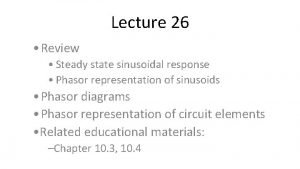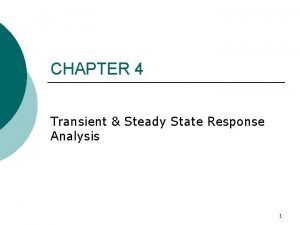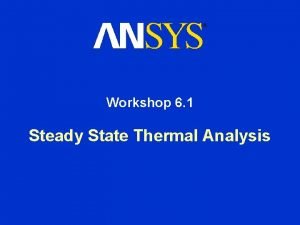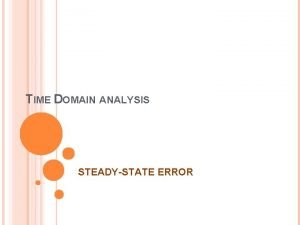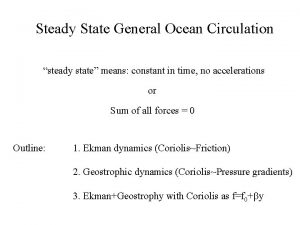Power in Sinusoidal Steady State All currents and












- Slides: 12

Power in Sinusoidal Steady State All currents and voltages are sinusoids with frequency “w”. Instantaneous power and average power (as time functions): Some relations: * ** *** Complex power (as phasors): Active Reactive power [Watt] [VAR]

Instantaneous Power and Average Power For a resistor: The power delivered to the resistor (by the source): from * Why always. . . . ? Instantaneous power oscillates twice in one period and. Average power: between

Instantaneous Power and Average Power For a capacitor: The power delivered to the capacitor (by the source): from ***. . . . . . . . . Instantaneous power oscillates twice in one period and. Average power: between

Instantaneous Power and Average Power For an inductor: By duality, the power delivered to the capacitor (by the source): Instantaneous power oscillates twice in one period and. Average power: between

Instantaneous Power and Average Power For a general 1 -port: The power delivered to the 1 -port (by the source): i + G v _ 1 -port circuit in SSS from *** Average power: The average power does not only depend on the magnitude of sinusoids but also on their phase differences. : Power factor affects the average power.

Remember that the phase of an impedance element V=ZI is given by If effective values are used, . .

Complex Power i Complex power delivered to the port by the source is defined as + G v 1 -port _ Active power [Watt] Reactive power [VAR]-Volt. Amper. Reactive

L. O. Chua, C. A. Desoer, S. E. Kuh. “Linear and Nonlinear Circuits” Mc. Graw Hill, 1987, New York

Conservation of Complex Power KCL+KVL Tellegen’s theorem Power is conserved. But what about the complex power? Theorem Consider a linear time-invariant circuit driven by a number of independent sources, all sinusoidal at the same frequency w. We assume that the circuit is in the sinusoidal steady state. Then the sum of the complex power delivered by each independent source to the circuit is equal to the sum of the complex power absorbed by each element of the circuit. Proof: Phasors that satisfy KVL Phasors that satisfy KCL From Tellegen’s Theorem L. O. Chua, C. A. Desoer, S. E. Kuh. “Linear and Nonlinear Circuits” Mc. Graw Hill, 1987, New York

Maximum Power Transfer Aim: For a circuit in SSS, find a ZL such that the active power delivered from the source to a ZL is maximum. Assume that Conservation of complex power Active power delivered from the source Conservation of active power Active power consumed by ZG PL is a function of ØIL and ILm. (RG and EG are constants. )

For a maxiumum PL IL ‘s maximum value:

o Maximum power transfer theorem: Assume that a 1 -port circuit is operating in the sinusoidal steady state at frequency w and that this circuit is driving a load impedance ZL. This one-port is specified by its Thevenin equivalent (EG, RG + j. XG). where RG > 0. The load impedance Z, will receive from the one-port a maximum average power if and only if Z L = ZG. In this case, the average power delivered to the load is given by. Since and only %50 of source energy is transmitted to the load. Nevertheless this is the best case as we not have any controll on. Example: Calculate the impedance value Z for the maximum power transfer to Z. Determine the power of Z in this case!
 Steady state current formula
Steady state current formula Sinusoidal steady state
Sinusoidal steady state Sinusoidal steady state analysis of coupled circuits
Sinusoidal steady state analysis of coupled circuits Sinusoidal steady state analysis practice problems
Sinusoidal steady state analysis practice problems Sinusoidal steady state analysis
Sinusoidal steady state analysis Steady state sinusoidal analysis using phasors
Steady state sinusoidal analysis using phasors Pseudo sinusoidal pattern vs sinusoidal
Pseudo sinusoidal pattern vs sinusoidal Compared with surface currents deep currents are
Compared with surface currents deep currents are Transient response of first order system
Transient response of first order system Steady state thermal analysis ansys
Steady state thermal analysis ansys Steady state error
Steady state error Pengangguran alamiah
Pengangguran alamiah Mitokondre
Mitokondre
